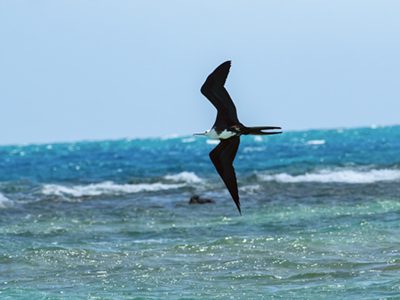
Seabirds and their association with fishing have long been acknowledged by anglers, both offshore and inshore. It’s often said that if you find the birds you’ll find the fish, and finding them has become a bit easier with new electronics via radar.
When I first started my career as a fishing guide I mostly focused on only three seabirds, the magnificent frigate bird, ospreys, and brown pelicans. I knew from experience that all three of these species could very easily lead an angler to schools of fish as well as much needed live baitfish.
However, as I spent more time on the water the inevitable question would arise, what kind of bird is that?
Admittedly, I could identify quite a few water birds such as rosette spoonbills, ibis, white pelicans, bald eagles, gulls and terns, but certainly not all of them, so a personal education was the only way to answer all these questions. I made it a rule when asked about one that I had no idea what it might be, to take a photo, look it up and reconnect to the person that asked the question with an answer.
Over the years I learned that ibis come in a lot of different colors. The adult white ibis are brown when they are young. There’s also the glossy, and the scarlet, one of the most beautiful reddish orange birds I’ve ever seen.
There are a ton of egrets and herons, where quite a few of them look very much like one another. And then there’s the shore birds. What I typically called sandpipers are actually in a group called charadriiformes. There are 390 species in this one group! Good luck trying to identify all of them.
Many years ago, my father gave me a navigation tip related to the shallow waters of back bays. He said, use crab trap floats to find your way across shallow areas. Crabbers want the traps covered with water at all times so during low tides it’s a pretty safe bet that you’ll have enough water to navigate through.
And then there was this. If you see birds walking in the water, don’t go there. Pretty simple, and something I’ve never forgotten.
For me offshore fishing comes in two categories, bottom and trolling. In my opinion, bottom fishing doesn’t need the engagement of birds showing the way, however trolling is a whole different ballgame. If you can locate birds, especially frigates or terns, working over the water, there will most likely be fish present.
This also holds true in the backcountry. Frigates almost always cruise over tarpon. If you watch their movement you’ll soon see they are heading in the same direction as the school of fish. This enables an angler to move ahead, set up, and intercept the tarpon as they approach.
Osprey love to ambush seatrout on the open flats. Granted, they also love mullet and ladyfish too, but at least when found you can be pretty much guaranteed a bite.
The next time you head out for a day of fishing, be sure to check the tides, the moon phase and the weather, but also do your best to locate birds. They are one of the best fish finders an angler can have.
